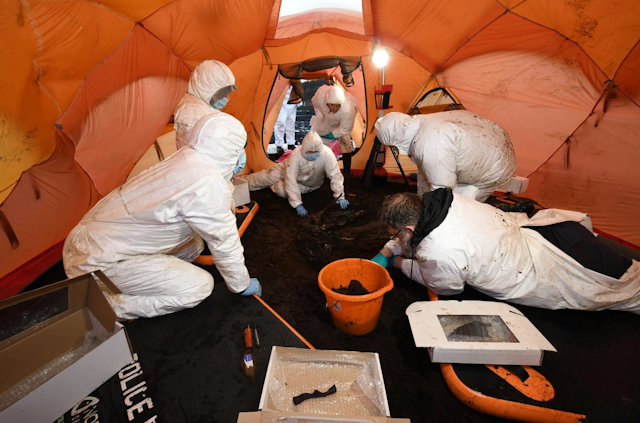Occasionally, police investigators find themselves announcing archaeological discoveries, rather than criminal findings. In 1984, for example, police oversaw the recovery of the Iron Age bog body (a naturally mummified corpse found in a peat bog) later called “Lindow Man” in Cheshire, UK. On January 25, 2024, the Police Service Northern Ireland (PSNI) found themselves doing just that.
The civilian discovery, and subsequent PSNI excavation, of a 2,000 year old bog body at Bellaghy, in the Londonderry county of Northern Ireland, is significant because of the rarity of prehistoric human remains that include soft tissue preservation. As with The Lindow Man, the initial investigations were conducted by the police in case the remains were those of a recent murder victim – making the location a crime scene rather than an archaeological site.
It was only following radiocarbon dating of the remains from Bellaghy that the body, by then identified as that of a young male, was shown to have lived during the Iron Age.
In a statement, Detective Inspector Nikki Deehan said: “On initial examination, we couldn’t be sure if the remains were ancient or the result of a more recent death. Therefore, we proceeded to excavate the body with full forensic considerations in a sensitive and professional manner. This approach also ensures that any DNA evidence could be secured for any potential criminal investigation.”
There have been at least 2,000 bog bodies recovered from Europe’s peatlands, with around 130 found in Ireland. Archaeological excavations of bog bodies are very rare, as the great majority of bog bodies are discovered ex situ – removed from their surroundings during peat cutting or by the actions of the finders.
The excavation of the Bellaghy Body by PSNI with support from forensic archaeologists points to the importance of careful and methodical recovery, for understanding both ancient and modern human remains found in peatlands.
Navigating the bog
Archaeologists need to understand context to interpret the past, and the peaty graves of bog bodies are no different. The Bellaghy body seems to have been found in situ, potentially offering valuable evidence associated with the circumstances of the death. This is important as it may assist in interpreting the violent ends met by other prehistoric bog bodies, some of whom have been interpreted as sacrificial victims.
Peatlands are remarkable archaeological archives, but the earth does not neatly divide traces of the distant and recent past. Archaeology and forensic science still have much to learn from each other. For example, the discovery of Lindow Man directly influenced the searches for the victims of the serial killers Ian Brady and Myra Hindley on Saddleworth Moor in 1986 and 1987.
During The Troubles in Northern Ireland, Irish Civil Rights leader Bernadette Devlin wrote about the IRA using a site called The Black Bog in County Tyrone, Northern Ireland, to hide evidence of their activities.
Ecocritic Maureen O’Connor and archaeologist Benjamin Gearey have explored the role of peatlands during the Irish War of Independence, sometimes used to hide both the dead and the living.
Since the signing of the Good Friday Agreement in 1998, The Independent Commission for the Location of Victim Remains (ICLVR) has sought to locate people who went missing during The Troubles, often referred to as “the disappeared”. In the commission’s search over the last 25 years, four people remain missing, including suspected IRA murder victim Columba McVeigh, who is believed to have been buried at Bragan Bog in the Monaghan county in Ireland.

The challenge of the bog
While forensic archaeologists have a very specific brief to fulfil, they are as likely to uncover traces of the distant past as they are traces of modern crimes.
In searching for modern victims of murder, the forensic archaeologist who uncovers evidence of the distant past has the same duty of care as all other archaeologists – to observe, record and recover traces of human activity. It is hoped that the PSNI recovery of the Bellaghy Boy will in time result in the release of information about the burial site for archaeologists to pore over.
Peatlands are challenging environments for both archaeological and forensic investigations. They are difficult to survey for traces of graves or evidence of recent disturbance, making it hard to detect anything other than the solid geology below the peat.
While peatlands might seem timeless in their appearance, they have changed significantly over the millennia. They have been subject to drainage and peat cutting for fuel, the planting of woodlands, agricultural use, settlement and burned for grouse raising. Most recently, some have been restored for biodiversity and carbon capture.
The peatland in which a person was buried in the 1970s might look very different to that under investigation in 2024, let alone two millennia ago.
Archaeologists are fascinated by change and continuity, and bogs offer both in spades. Peatlands have long provided locations where bodies might be deposited without apparent trace, and even today we often rely on chance to bring them to our attention.
The riddles of finding a body in a bog perplex police investigators, archaeologists and forensic scientists alike. While the archaeological record may show strikingly similar patterns of body deposition across time, very different motives and interpretations might lie behind these cases.
We need to think in terms of developing “best practice” for excavating future bog bodies, drawing on contemporary approaches to investigating homicides. The work of the PSNI at Bellaghy could provide invaluable insights in this regard.
For archaeologists and forensic archaeologists, the future recording and reporting of bodies found in the bogs of Europe might help us better understand what human stories lie behind the patterns of those trackless, mossy graves.

Looking for something good? Cut through the noise with a carefully curated selection of the latest releases, live events and exhibitions, straight to your inbox every fortnight, on Fridays. Sign up here.

